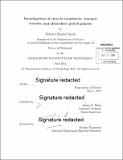| dc.contributor.advisor | Joshua N. Winn. | en_US |
| dc.contributor.author | Ojeda, Roberto Sanchis | en_US |
| dc.contributor.other | Massachusetts Institute of Technology. Department of Physics. | en_US |
| dc.date.accessioned | 2014-10-21T17:24:35Z | |
| dc.date.available | 2014-10-21T17:24:35Z | |
| dc.date.copyright | 2014 | en_US |
| dc.date.issued | 2014 | en_US |
| dc.identifier.uri | http://hdl.handle.net/1721.1/91075 | |
| dc.description | Thesis: Ph. D., Massachusetts Institute of Technology, Department of Physics, 2014. | en_US |
| dc.description | 234 | en_US |
| dc.description | Cataloged from PDF version of thesis. | en_US |
| dc.description | Includes bibliographical references (pages 237-261). | en_US |
| dc.description.abstract | Over the past 20 years, approximately 1700 planets outside of the solar system have been found. Known as exoplanets, they represent a great opportunity to answer some of the deepest questions about the origin and evolution of our solar system. In this thesis I focus on transiting exoplanets, planets that eclipse their host star from our point of view, reducing momentarily the stellar flux detected by our telescopes. In the first part of this thesis, I develop a new method to measure obliquities, the angle between the spin axis of the star and orbital plane of each of the planets. In our solar system, the obliquity of all planets is within a few degrees of zero, a natural consequence of the standard theory of planet formation, in which a rotating envelope of gas collapses into a disk-shaped protoplanetary disk from which the planets form. But this is not the case for all exoplanets. Close-in gas giants are frequently found in orbits that are tilted respect to the spin axis, a sign that some process is altering the orbits of these planets.The new technique I develop in this thesis uses the passage of a transiting planet over starspots to obtain information about the obliquity of its host star. In particular, I show how to use this technique for close-in gas giants with low and high obliquities, and I extend it to longer orbital periods and multi-planet systems, where obliquity measurements are scarce and therefore more interesting. In the second part of this thesis I describe a survey to detect the shortest-period planets discovered with the Kepler space telescope. In this survey I take a different approach to discover ultra-short period transiting exoplanets. A simple Fourier transform is obtained for every Kepler star, and planets are detected by interpreting the amplitudes and frequencies of the different peaks of the Fourier spectrum. This technique has allowed us to detect Kepler-78b, currently the smallest planet with a mass and radius measurement, with an extreme orbital period of 8.5 hours. The last chapter of this thesis is devoted to the survey, from which a list of 106 planet candidates with orbital periods shorter than one day emerged. The properties of these planet candidates are ultimately used to understand the characteristics of ultra-short period planets in general. | en_US |
| dc.description.statementofresponsibility | by Roberto Sanchis Ojeda. | en_US |
| dc.format.extent | 261 pages | en_US |
| dc.language.iso | eng | en_US |
| dc.publisher | Massachusetts Institute of Technology | en_US |
| dc.rights | M.I.T. theses are protected by copyright. They may be viewed from this source for any purpose, but reproduction or distribution in any format is prohibited without written permission. See provided URL for inquiries about permission. | en_US |
| dc.rights.uri | http://dspace.mit.edu/handle/1721.1/7582 | en_US |
| dc.subject | Physics. | en_US |
| dc.title | Investigations of close-in exoplanets : starspot transits, and ultra-short period planets | en_US |
| dc.title.alternative | Starspot transits, and ultra-short period planets | en_US |
| dc.type | Thesis | en_US |
| dc.description.degree | Ph. D. | en_US |
| dc.contributor.department | Massachusetts Institute of Technology. Department of Physics | |
| dc.identifier.oclc | 892611953 | en_US |
